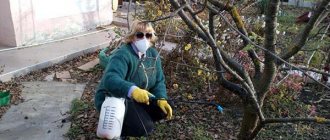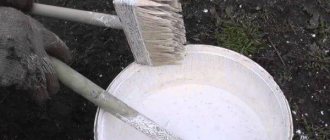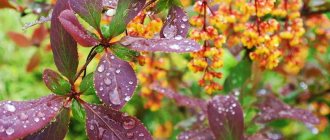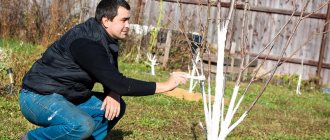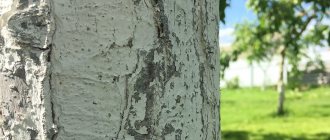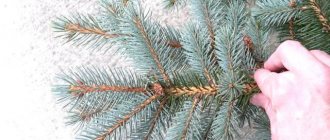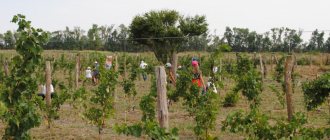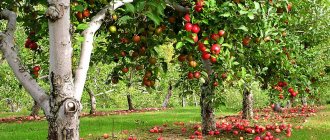Whitewashing trees is a long-known agrotechnical technique. However, some summer residents neglect it, considering it an unnecessary decorative relic of the Soviet past. But whitewashing is very important for trees. In this article we will talk about the benefits of this procedure, the most effective formulations and some important nuances that will be useful to know about.
Dear readers! For you, we have created communities on social networks in which useful articles and interesting ideas are published several times a day! Subscribe and receive useful content in a convenient format!
Why whitewash trees
The procedure for coating the lower part of tree trunks with a composition based on emulsion or lime has two main functions:
- Protection from harmful environmental factors, namely: changes in night and day temperatures, heating by direct sunlight during thaws, winds, freezing rain and frost.
- Protection from parasites. The composition with which you coat the wood closes microcracks in the trunk and prevents pests and pathogenic microorganisms (fungi, bacteria, viruses) from penetrating into the internal tissues of the tree.
In this case, the procedure must be carried out with both young and old trees. The applied white protects young trees with a delicate and thin top layer from spring temperature changes, when the sun warms up the trunk during the day and frosts occur at night. Without whitewashing, the protective part of the wood of a young tree may crack, which will lead to injury to the internal tissues.
Whitewashing older specimens serves the same purpose. Usually their entire bark is covered in cuts, cracks, chips and small wounds. The applied paint clogs the ulcers and creates an impenetrable thin film.
This film does not allow parasites, fungi and bacteria inside.
INTERESTING. The practice of whitewashing roadside trees was widespread during the Great Patriotic War. Trees along the roads were whitewashed so that military vehicles could move at night with the lights off, without fear of enemy air raids.
What are the benefits of whitewashing?
The bark on the trunk is like human skin, which is protected by clothing from frost, burning sun and bad weather. The tree also needs protection.

Under the influence of cold, the bark cracks, burns appear from bright rays, harmful insects bore it, and voracious animals gnaw it. Simple and clear instructions are available on the portal of summer residents dachnichek.ru.

Therefore, gardeners use whitewash, which:
- prevents the sun from burning the bark before foliage appears;
- protects against cracking due to temperature changes;
- not to the taste of animals who prefer to feast on young trees;
- expels insect pests and their larvae.
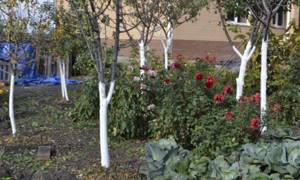
And an intact trunk does not allow various diseases to penetrate inside, leading to the death of the tree.
When to whiten trees in the garden in spring

During the season you need to carry out from 1 to 3 procedures:
- Before the plants awaken, in March or even the last days of February;
- Summer (July);
- After harvesting and leaf fall (October - November).
The number of procedures depends on the condition of the trees, as well as the quality and durability of the composition used.
Spring whitewashing is in most cases of an auxiliary nature. With this painting we renew the top protective layer. If the white has completely disappeared over the winter, then a full painting is carried out.
It is necessary to carry out a full-fledged spring procedure in the very first days of spring, and, if you did not whitewash in the fall, then even in the last days of winter!
The choice of a specific date correlates with the outside temperature. It is not advisable to work in freezing temperatures, but there is no need to wait for warming to reach 10 degrees. Try to whiten trees on a clear day when the temperature is around 3-5 degrees Celsius.
The benefits of painting are obvious. While the tree stands without leaves, it is easily warmed up by the March sun. Sap flow begins. The bark and internal tissues heat up. But at night the temperature drops, and in the morning it can even be frosty. As a result, the internal fluids freeze and the wood bursts. Cracks appear - frost holes.
The applied white paint protects the wood.
There is no need to rush into repainting. It can be carried out in the second ten days of March and even in the first days of April.
IMPORTANT! It is necessary to carry out whitewashing before starting the main gardening work.
When should whitewashing be done?
According to the recommendations of experienced gardeners, the solution treatment procedure should be carried out 3 times a year:
- in October-November;
- at the end of February - beginning of March;
- in July.
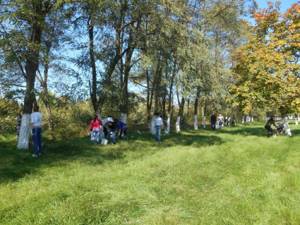
But it is not always possible to follow the advice. Then, when do you need to whitewash trees so that a one-time treatment will help preserve the garden?

Is it worth whitewashing trees in the fall?
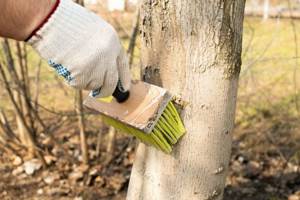
Many summer residents consider autumn whitewashing unnecessary, although the situation is exactly the opposite. It is necessary to carry out the procedure in the fall. The time to plan whitewashing is after the leaves have fallen. In different regions of our country it is October or November.
It should be about 3-5 degrees Celsius outside. It is better to start working in the morning, but after the dew or frost has passed. This way the paint will dry and not peel off on the first night.
The autumn procedure is considered the most effective.
This is due to the fact that tree bark during the winter becomes both a refuge for pests and parasites and food for rodents. Also, the outer shell of wood suffers from icing, severe cold winds, frostbite, etc.
The applied composition acts as a shield that does not allow fungal spores to pass through, prevents insects from penetrating under the bark and protects from atmospheric exposure.
Based on all of the above, we can conclude that autumn whitewashing is an important part of garden care.
How to whitewash trees?
Since Soviet times, fruit and ornamental trees have been whitewashed with ordinary slaked lime. This is an affordable, cheap material. He is easy to work with. But there are also disadvantages. Lime provides little protection and is easily washed off by rain.
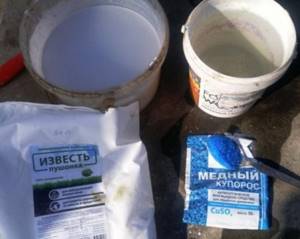
Nowadays, hardware stores provide the gardener with a huge selection of whitewashing products. These include chalk and lime for trees, water-based paints and acrylic paints. The latter are much more effective than lime and chalk mortar, but they are also significantly more expensive.
Lime and chalk mixtures do not adhere well to wood, so glue or soap is added to them. Also, for disinfection, copper sulfate or Bordeaux is used as an additional component.
A more modern option is water-based, acrylic and water-dispersed paints. These are ready-made formulations that contain components for adhesion and disinfection. The paint sticks to the bark quite well and also allows the trunk to “breathe.” The disadvantage of using paints is that you can only work at +3 (minimum permissible temperature).
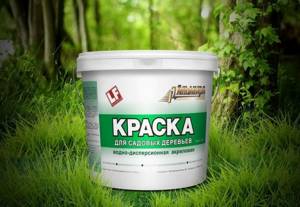
Another good, but rather expensive option is acrylic paint. It lasts for two winters, is easy to apply and does not require additional treatments.
IMPORTANT! Garden whitewash must meet the following requirements. Firstly, the barrel must “breathe”. Secondly, do not wash off or rise up like a fur coat.
What kind of lime should I use?
Lime mortars are still widely used for whitewashing. It is necessary to buy lime for gardening work, and not building mixtures.
It is extremely important to prepare the suspension correctly. The solution should look like sour cream. That is, so that it does not flow like water and fall off like a fur coat.
Dilute lime together with adhesive and copper sulfate. You can use PVA, casein glue and Bordeaux glue as a replacement for copper sulfate.
The simplest recipe looks like this: take a bucket of water, pour 2.5 kg of lime into it, stir, add 0.5 kg of vitriol and 200 grams of glue. Mix everything thoroughly so that there are no lumps. It is better to add water gradually so as not to add too much.
We give a little time for the suspension to thicken and begin to evenly cover the bark with the composition.
NOTE! You can paint trunks only with slaked or quicklime. Do not coat living wood with bleach.
Preparation of the solution
The most common whitewash mixture is made from slaked lime or mountain limestone. Gardeners choose this substance because:
- a dense insulating layer is created;
- its aseptic properties are manifested;
- after drying, it turns out to be a snow-white shade that can reflect the sun's rays.

Before preparing a solution of lime, you need to correctly select the proportions. Young seedlings should take a lower concentration of the substance so as not to damage the bark. For older trees, the classic ratio is suitable.

How to dilute lime for whitewashing trees in spring
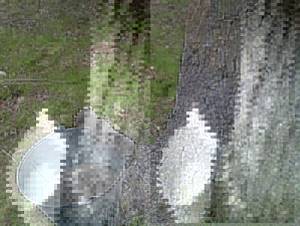
If you choose slaked lime for work, then dilute it as follows.
A packet of lime is poured into a container and poured with a mug of hot water. Next, you need to stir until a homogeneous mass is obtained. Next, add more water so that the solution thickens and begins to resemble sour cream. All this time you need to stir.
To obtain “milk” the proportion should be: 3 parts water to 1 part lime. But at the same time, you must add glue (casein or PVA) so that the composition sticks to the bark.
ON A NOTE. Don't pour in a lot of water at once. Add it gradually and mix thoroughly.
If you choose quicklime, then first of all you need to slak it. A couple of hours before the procedure, fill the boiling pot with hot water (a bucket of water is needed for 3 kg). The extinguishing process will begin, which will take about 40 minutes. Then it takes another hour for the suspension to cool.
Next, add the adhesive, about 500 grams of Bordeaux mixture or copper sulfate, mix thoroughly again and evenly cover the lower half of the barrel.
Whitewashing trees with lime - preparation of solution and proportions
Most often, lime is used for whitewashing, since it helps well both as protection from the sun and from pests getting inside.
You need to use slaked lime: for this, take pieces of lime and cold water (in equal proportions). The components are mixed, a peculiar reaction is obtained - hissing.
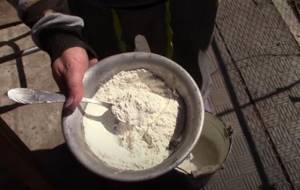
During the process of slaking lime, you need to protect your hands and eyes - wear goggles and gloves. This is important to do, since the temperature of the mixture during the hissing process rises to 150 degrees.
Next, a solution for whitewashing trees is made from the resulting composition: take 2.5 kg of ready-made slaked lime, 10 liters of water and 1 kg of clay. Instead of clay, you can add laundry soap - you will need 10 tablespoons of soap shavings.
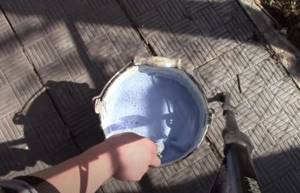
Lime has a wide range of uses: in construction, gardening, animal husbandry, for disinfection, even in the preparation of certain products. But you need to work with it carefully, protecting your skin, because it is a caustic compound.
How to dilute lime for whitewashing trees in autumn
Autumn whitewashing must be approached very responsibly. It is better to take sustainable garden paints. They will not be washed away by autumn rains. And this is very important. If you can easily apply lime in the spring and then renew the whitewash in the summer, then you won’t be able to renew the autumn paint job in the winter.
But, if you decide to use lime the old fashioned way, then be sure to mix the paste into the mixture.
The simplest and most effective whitewash recipe is this:
Thoroughly mix 2 kg of slaked lime with 2-3 tablespoons of flour paste and 0.3 kg of copper sulfate to obtain a homogeneous “flour”.
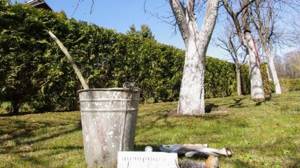
Now we begin to add water and mix thoroughly. You need to fill a bucket with water. Maybe a little less. The main thing is that you get sour cream. But you don’t need to make it too thick either. One should be smeared with a brush, and not stick in lumps.
It is better not to whiten very young trees with this composition. But already mature, strong specimens can be treated with such lime.
Indelible whitewashing of trees, what is it?
As the name implies, this is a composition that does not disappear from the tree an hour after the first rain begins.
If you want to protect your garden for a long time, then use garden paint as a permanent whitewash. You can take any: acrylic, water-dispersion, water-emulsion. Choose according to your budget.
The best of these three is acrylic, but it is the most expensive. Its advantage, in addition to its long service life, is the presence of special components that are beneficial for the bark and fight pests and fungi.
Buy paint only from trusted manufacturers, do not try to save money by buying a cheap Chinese product. In this case, it is better to buy proven and inexpensive garden lime.
How to whitewash trees step by step?

Before you begin the procedure, you need to determine the height of whitewashing of fruit and ornamental trees.
Ideally, you need to cover the entire tree. But in practice this is almost impossible due to the high cost of the procedure and its complexity.
The minimum height of whitewashing is the part of the trunk from the base to the first skeletal branch. If you do not have a very large garden, or you have enough whitewash, then you can also whitewash the lower branches up to half their length.
The first step is to clean the barrel.
Over the summer, the lower half of the tree becomes abundantly covered with moss, peels off, and cracks. Among other things, it is gnawed by parasites and damaged by fungi. All this needs to be removed from the tree. Cleaning must be done carefully so as not to cause further injury to the plant. You need to use washcloths, rags, and soft gloves. Iron tools are not recommended.
Cleaning should be done in wet weather. If it is dry outside, clean the tree trunks in the morning, before the sun rises too high.
Wood chips, dirt, moss and other debris are carefully collected and burned, as they contain harmful bacteria, insect eggs, fungal spores, etc.
The second step is disinfection treatment.
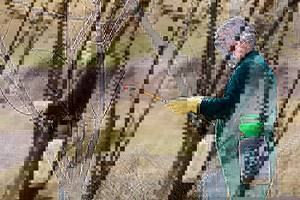
After cleaning the bark, we disinfect it. It is needed to get rid of clutches of insect eggs, larvae and pathogenic microorganisms. Disinfection of wounds and cracks also occurs.
Disinfection is carried out with copper-containing agents (for example, Bordeaux mixture, copper sulfate). The drugs HOM and Oxychom are also quite effective. From available means, you can use a solution based on ash and laundry soap (3 kg of ash per bucket of water and a bar of soap for sticking).
When carrying out disinfection, it is worth alternating ash infusion and copper-based preparations. This is necessary so that copper does not accumulate in the plant tissues and the soil around it.
The third step is to seal the cracks.
Next, we seal all the wounds and cracks that we see. You need to use special preparations: garden pitch, paste or biomask. You can use any drug that is available to you at your nearest hardware store.
But it is not advisable to cover wounds with ordinary enamel. This paint contains harmful chemical compounds that poison the tree and accumulate in the fruit. Then it is better to use clay with manure. But in general it is better to buy garden paste. It's inexpensive and will last a long time.
The fourth step is whitewashing.
When the preparatory stages are completed, we cover the tree bark with whitewash. It is best to use modern preparations that do not wash off for a long time and have less impact on the wood.
For whitewashing, you can use a regular brush, although there are special brushes for whitewashing.
ON A NOTE. Carry out the procedure carefully, do not leave unpainted areas.
IMPORTANT! When preparing the solution, bring it to a homogeneous consistency. There should not be too thick sediment. Otherwise, it will turn out that the liquid you apply to the bark is ordinary colored water, and not a drug.
How should wood be processed?
For beginners in gardening, it is better to take a photo of correctly whitewashed trees as a basis in order to accurately determine to what level the trunk needs to be processed.
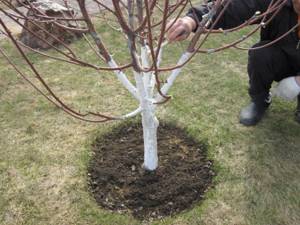
If there is no clue nearby, then you need to whitewash:
- the entire trunk or in other words the trunk from the base to the first branch;
- bark along the entire height of the trunk along with a third of the lower branches;
- half the trunk for ornamental trees with a high, formed crown.
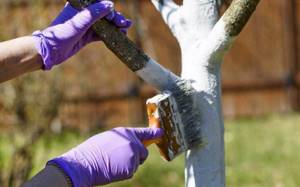
According to experienced gardeners, the best option is to treat the entire tree, especially before the onset of winter, or to a 2-meter height.
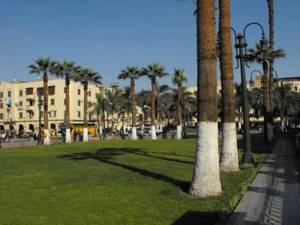
We recommend watching

How to make an extension to a wooden house - step-by-step instructions for designing and building an extension (105 photos and videos)

How to trim grapes - detailed instructions for beginners, the procedure for performing the work and a step-by-step description of the pruning process (115 photos)
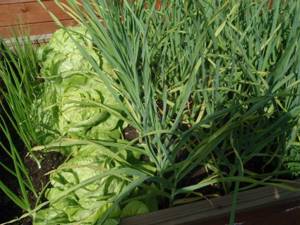
What is the lunar landing calendar used for: features and rules for using the lunar calendar
Is it possible to whitewash trees with water-based paint?

Specialized paints for garden trees are becoming increasingly popular. The most popular type is water-based paint. Its advantage is that it holds well, withstands rain and snow and is almost completely safe for wood. In addition, special substances included in the paint form a protective film on the surface, which protects against overheating and moisture, but allows the wood to “breathe”.
Water-based emulsion is well suited for treating young trees because it causes virtually no harm to the bark.
There is also an option with water-dispersion paint. It contains useful additives that protect the bark.
Water-based paints take about a day to dry.
An important point is the operating temperature. It must be above zero, and even +7 heat is recommended. Therefore, they whiten with paint a little later than with lime mortar. However, if you carried out the autumn whitewashing with water-based emulsion, then this will not become a problem. It holds up well, and it will be possible to update it in April.
NOTE! The paint must certainly be intended for living wood. You cannot use regular paints from a hardware store.
How to avoid mistakes?
Beginning gardeners often complain that bark treatment was ineffective and the tree died. And the reason is that they simply “painted” the wood without any preliminary preparation. Therefore, some tips for beginners for competent whitewashing:
- The trunk and lower branches must be cleared of lichens and other growths. It is better not to use tools to avoid damage.
- Clean out cracks and deep scratches with a sharp peg.
- Disinfect cleaned areas with copper sulfate or other fungicide.
- Repair deep damage with clay mortar, garden varnish or special “Rannet” paste. Leave until completely dry.
- Now you can proceed directly to whitewashing.
Processing trees with special solutions does not carry any decorative loads, so it is not necessary to do everything according to the ruler and at the same level.

The main thing is to observe the proportions when preparing the mixture and to carry out the procedure itself correctly.

What trees can be whitewashed?

Almost all trees need to be covered with whitewash. Particular attention should be paid to young plants. They still have a weak bark, which does not protect the core well.
Also, special attention should be paid to valuable and most productive varieties.
You can whitewash not only fruit trees, but also decorative ones that do not bear fruit, but simply decorate your garden. After all, they also suffer from bad weather and pests in winter.
And the applied white will protect them and protect them from diseases.
Which trees should not be whitewashed?
In general, it is not recommended to whitewash only newly planted trees. Applying a protective layer will be stressful for them and may have a negative impact.
To protect the seedling from negative influences, it is better to cover it with a special protective belt or wrap it with rags.
If you still decide to whiten young seedlings, then reduce the concentration of the active substance by half or three times.
There is no need to whitewash trees older than 30 years. They already have a thick enough bark to protect their internal tissues. In addition, the process of stripping the barrel will do more harm than good.
In summer as needed
July whitewashing is performed when the tree needs additional protection. This is a massive attack of insects, especially stag beetles, which can gnaw the bark of a young seedling.
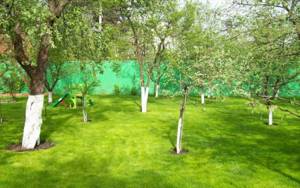
Or early shedding of leaves in the scorching sun. Another reason for unscheduled processing is the appearance of cracks in the trunk.
Do young trees whiten?

There is a fairly widespread opinion that young trees should not be subjected to the procedure, since the chemicals that make up the whitewash can injure the tree. Plus, the paint prevents the trunk from growing wider, as it compresses it.
There is some truth in this statement. Indeed, lime (especially the most common one) can burn the bark. But, if you carry out the procedure using modern means or reduce the concentration of lime by half, then whitewashing will not cause any harm.
But it is necessary to carry out the procedure with young trees. The fact is that in the spring, due to sharp fluctuations in day and night temperatures, the tender trunk of a tree will receive both sunburn during the day and frost damage at night.
And the applied composition will act as a shell. Light paint will reflect the sun's rays and prevent the barrel from overheating.
ON A NOTE. If you planted trees in the fall, you need to cover them with a protective layer both before winter and after the snow has melted. That is, next spring.
Whitewashing in autumn
Experts consider the most basic treatment to be autumn. The prepared solution helps get rid of insects that have occupied the tree for wintering.
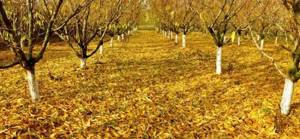
It will also give the bark an unpleasant taste, which will repel hares and other animals that prefer to gnaw on the trunks.
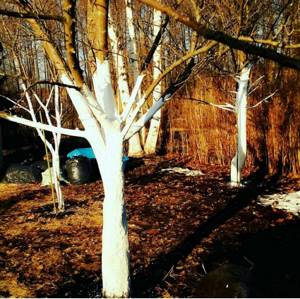
It will also help protect trees from icing, after which the surface of the bark often cracks, since whitewashing creates a kind of protective heat-insulating layer.
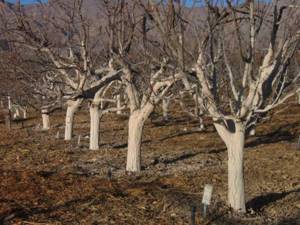
Plus temperatures during the day and frost at night also provoke the appearance of cracks if the wood is not treated.

At what temperature can the procedure be performed?
The spring procedure is carried out on a dry, sunny day. It is advisable that it is no higher than 5 degrees Celsius. Optimally - about 3 degrees.
If you are working with water-based paint, you will have to whiten when the temperature reaches at least 3 degrees Celsius. Recommended temperature is 7 degrees.
Also an important condition for the procedure is dry and preferably calm weather. This way the applied solution will dry on the bark and will not be washed away by the first rain.
Whitewashing should be done during the day, preferably around lunchtime (maybe a little earlier). This choice of time of day is due to the fact that the air will warm up and morning frosts (if any) will pass, and the whitewash will have time to dry before the evening cold snaps.
ON A NOTE. In summer, it is better to carry out the procedure in cloudy but not rainy weather, after about 10 a.m., but before the onset of midday heat.
What is the best way to whiten trees in autumn and spring?
Agronomists strongly recommend whitewashing on a warm day without rain, so that precipitation does not wash away the applied composition. The temperature should already be above zero, not lower than 5 degrees.
There should be no significant frosts at night so that an icy crust does not form on the bark, otherwise the whitewashing procedure will be pointless.

If the tree has just been planted, it is not yet recommended to whiten it; only next year will it be possible to begin this agrotechnical activity.
The most environmentally friendly and safe composition for autumn whitewashing is made from clay and mullein. Basically, it is used in Western countries, as lime is considered harmful to green spaces.
To prepare the composition, dilute yellow or white clay to the consistency of thick sour cream, add ash and mullein.
In this case, the clay perfectly protects the bark from the sun and the penetration of pests, and mullein helps the clay to stay on the tree well throughout the winter.
In addition, mullein provides additional nutrition.
In the autumn, it is necessary to whiten fruit trees: apple, cherry, plum, pear. It is advisable to do this before frost sets in - October is ideal.
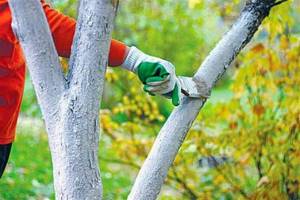
In the spring, lime or chalk is best suited for whitewashing, but the latter, although effective against the sun, adheres to the bark very poorly and will be washed off quickly, literally after the first precipitation falls. It is best to prepare a composition based on lime, vitriol and glue (recipe above).
Lime will protect from the sun, glue will help the composition to firmly attach to the tree, and vitriol will save you from infections, diseases and pests.
In spring, whitewashing begins with the onset of positive temperatures (not lower than +5). This usually happens in March, in some regions if warming occurs earlier, then you can start whitening earlier - in February, but so that there are no night frosts.
